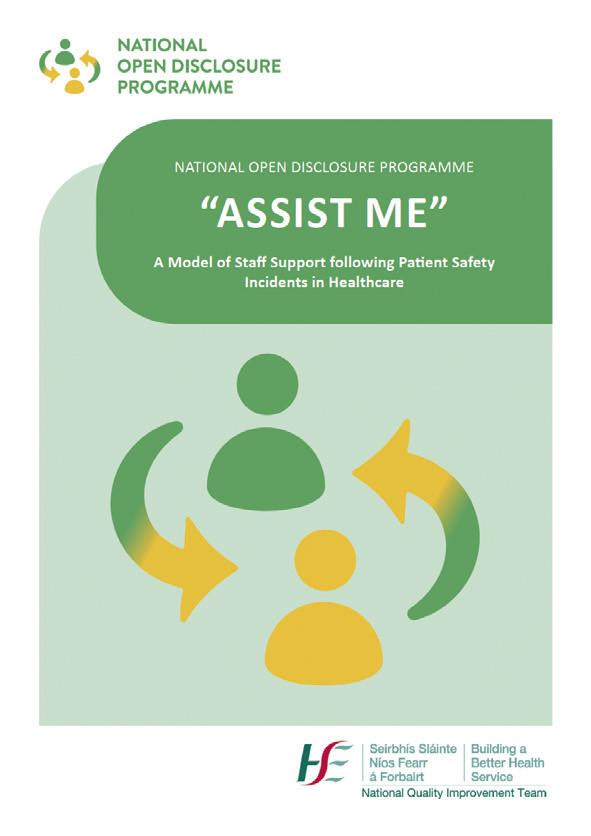
4 minute read
Open disclosure – training for staff
OPEN DISCLOSURE
Training and resources to support staff with Open Disclosure
Open Disclosure is defined as an open, consistent, compassionate and timely approach to communicating with patients and, where appropriate, their relevant person following patient safety incidents. It includes expressing regret for what has happened, keeping the patient informed, and providing reassurance in relation to on-going care and treatment, learning and the steps being taken by the health services provider to try to prevent a recurrence of the incident. The National Open Disclosure Programme supports the implementation of The HSE Open Disclosure Policy by guiding sta who are managing open disclosure meetings with patients/ service users and families. Open Disclosure Training is mandatory for all sta with refresher training three yearly. In-person training was suspended due to COVID-19 restrictions. This has been addressed by the provision of e-learning programmes on HSELanD.
Module 1 - Communicating E ectively through Open Disclosure outlines the principles of open disclosure and the role of all healthcare sta in ensuring that honest and timely communication occurs when something goes wrong in the course of providing healthcare. This module launched in April 2020, meets the mandatory training requirements for sta . It has been awarded 2 external CPD points (RCPI) and 2 CEUs (NMBI). More than 51,000 sta have completed this module to date. Module 2 - Open Disclosure: Applying Principles to Practice is a follow on module and is aimed at sta involved in formal open disclosure meetings. It includes a number of case scenarios in di erent healthcare settings and provides guidance on managing some of the complexities that may arise. This module has been awarded 3 external CPD points (RCPI) and 3 CEUs (NMBI) and has been completed by over 2,000 sta since it was launched in April 2021.
These modules are currently available on the Interim version of HSeLanD.
YOUR SAY
Feedback on the e-learning modules from sta includes, “Excellent videos - I really felt they were just like real life scenarios”; “I will recommend this to others especially to my colleagues”; “Very well presented and easy to navigate online course.”
THE ASSIST MODEL OF COMMUNICATION
A: ACKNOWLEDGE
Acknowledge what happened and the impact.
S: SORRY
Provide a sincere apology / expression of regret.
S: STORY
Listen to their story without interruption and acknowledge your understanding of what they have said.
I: INQUIRE
Encourage questions and provide factual answers, as available.
S: SOLUTIONS
Discuss and agree solutions and next steps.
THE ASSIST ME MODEL -
SUPPORTING STAFF FOLLOWING PATIENT SAFETY INCIDENTS The importance of support for staff from line managers, colleagues and peers in the aftermath of a patient safety incident should not be underestimated. Being available for staff and hearing/acknowledging their story surrounding the event is crucial. Staff require a safe and confidential space in which to discuss the incident and can find this therapeutic.
T: TRAVEL
Maintain communication and continue to provide support. Follow through on actions agreed.
AACKNOWLEDGE with empathy the incident that has occurred and the impact on the member of staff. ASSESS the impact of the incident on the member of staff and on their ability to continue normal work.
SSORRY - express regret for what has happened and for their experience.
SSTORY – allow time and space for the member of staff to talk about what happened and how they are feeling. Demonstrate understanding. Share experience, as appropriate.
The Assist Model of Communication was developed by the Medical Protection Society I INQUIRE – encourage questions. INFORMATION – provide information.
Document Reference Number: NATOD-QRG-010-02SUPPORTS AND SOLUTIONS Informal Emotional Support:
Demonstrate empathy and compassion. Be available and accessible to provide support, as required.
S
Formal Emotional Support:
Assess any immediate needs and discuss supports available including referral process. e.g. HSE Employee Assistance Programme (EAP), Occupational Health and/or GP. Practical Support:
Discuss and agree immediate working arrangements e.g. ability of staff member to continue with normal duties – consider allocation to other duties, as appropriate. Provide contact details for staff liaison person.
OTHER RESOURCES DEVELOPED TO SUPPORT STAFF AND SERVICES INCLUDE:
TTRAVEL – provide continued support and reassurance going forward and throughout the incident review/open disclosure process.
M
MAINTAIN contact and ongoing communication. MONITOR progress – check in regularly with the staff member. MOVE forward with guidance and support.
EEND – close this support process when the staff member feels ready. Remain available. EVALUATE the staff members experience of the support process and use learning to benefit other staff.
NOTE: This model has been adapted from the MPS Assist Model of Communication
Visit the HSE Open Disclosure website where you can access the full ASSIST ME staff support booklet
www.hse.ie/opendisclosure
Employee Assistance Programme (EAP) is a free, confidential counselling service and offers support for you or your team when required and following a critical incident.
EMPLOYEE ASSISTANCE PROGRAMME (EAP)
CALL 0818 327 327
Go to www.hse.ie/EAPandME to access the online hub of helpful resources.
• The Open Disclosure Quick Reference Guide and Tool Kit
which provides guidance for clinicians and teams who are participating in formal open disclosure meetings, meeting checklists, documentation template and sample language that may be used to support di cult conversations.
• A Role Description and Checklist for the Designated
Person which supports sta who fulfil this key role which is essential in improving the experience of patients/ services users and their families during the incident management and open disclosure process.
• The Assist Me booklet and poster which provide practical information and guidance on the supports available for sta a ected by patient safety incidents
• Guidance is also available on the Management of Open
Disclosure and challenges arising during the COVID-19
Pandemic.










